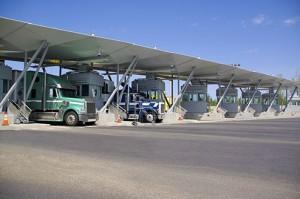Every day, U.S. borders process some 992,000 passengers and pedestrians, 270,000 incoming privately owned vehicles and more than 67,000 truck, rail and sea containers. For shippers hoping to convey products by tractor or trailer, these numbers also could deliver delays and interruptions.
How can a logistics manager streamline efficient cross border shipping? During a recent webinar, I discussed ways to improve better flow across the U.S.-Mexico border. Though specific to the countries’ shared 2,000-mile border, many of the strategies can be applied to Canada crossings as well.
- Know what’s in motion. Mapping the flow of materials can help identify what’s being shipped – how much, to where, by when and by whom. Such tracking should include intended milestones for goods’ arrival at or departure from the border, transit times, buffer times for inspection and any delays common to the supply chain or route.
- Create open lines of communications across your and partner organizations. This may seem intuitive. But in reality, a deadline missed or arrival overlooked because two partners didn’t communicate effectively can throw a shipment off schedule.
Getting critical, real-time information to the right people at the right time can help them make informed decisions along every step of the logistics chain. Consider engaging a third-party logistics provider – the “air traffic controller” coordinating all partners. Finally, exchange contact information for key decision makers, especially those who may be called on weekends or afterhours should an emergency arise.
- Avoid border delays. No one wants to wait at the border for hours due to missing paperwork or lack of coordination between customs brokers and carriers. Are your importation documents ready, from your instruction letter and invoices to powers of attorney? Are relationships in place at specific ports or border crossings? Are those ports or borders subject to high seasonal delays, like during agricultural season? Do the crossings limit hours of operation, commercial traffic, hazardous materials or specific loads? Consider such delays when calculating transit times.
- Use interchange agreements to avoid border transloads. These agreements enable one carrier to legally haul the other carriers’ trailers in another nation. When used properly, they can streamline shipping and reduce the need for offloading and reloading shipments to approved trailers.
- Be vigilant about cross-border security. Each day, U.S. agents seize 11,945 pounds of drugs, almost $300,000 in undeclared or illicit currency, and $4.7 million dollars’ worth of products with Intellectual Property Rights violations.
Protect your cargo and containers from intrusion, theft or damage. From secure drop lots and the use of security monitoring and access control, to on-site guards and visible CCTV cameras, to trailers carrying valuable contents being equipped with GPS monitoring, security is as important as the cargo is valuable.
You should also participate in government-sponsored programs. The Customs-Trade Partnership Against Terrorism (C-TPAT), FAST: Free and Secure Trade for Commercial Vehicles, and BASC: Business Alliance for Secure Commerce, or Mexico’s NEEC program, can expedite clearance for registered shippers, boost supply chain security, employ international security best practices and create an effective web against crime.
Truck trade between U.S. and Mexico is expected to hit $463 billion by 2020, notes Automotive Logistics magazine. American companies hoping to tap this market should seek efficiencies at every point in the pipeline.
To learn more, watch the entire webinar on cross-border security best practices. Those interested in more information regarding cross-border supply chains, U.S.-Mexico trade and the auto industry should also attend the first Automotive Logistics Magazine’s Mexico Conference taking place January 27th through the 29th.
Written by Frank Bateman
Frank Bateman is Director of Customer Logistics for Ryder Supply Chain Solutions. Frank leads the Ryder Cross-Border Solutions team that provides 3PL, Transportation Management, Distribution Management, and Customs Brokerage services to customers on both sides of the U.S.-Mexico border, managing more than 80 carriers and 3,000 border crossings per week.

